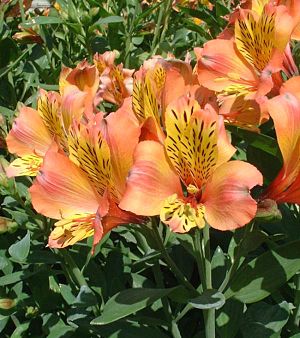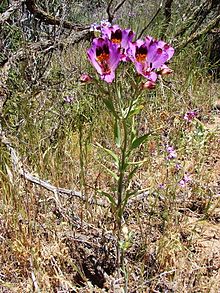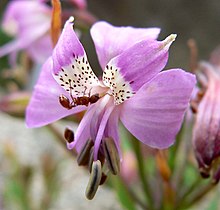Inca lilies
| Inca lilies | ||||||||||||
|---|---|---|---|---|---|---|---|---|---|---|---|---|

Inca lily ( Alstroemeria Aurea hybrid) cultivar 'Saturne' |
||||||||||||
| Systematics | ||||||||||||
|
||||||||||||
| Scientific name | ||||||||||||
| Alstroemeria | ||||||||||||
| L. |
The Inca lilies ( Alstroemeria ) are a genus in the family of the Inca lily plants ( Alstroemeriaceae) within the order of the lily-like (Liliales), so they belong to the monocot plants (Liliopsida). The genus was named by Carl von Linné in honor of the Swedish merchant and botanist Claes Alströmer (1736–1794). There are about 126 species. From a few species, very many varieties were bred, especially from Alstroemeria aurea (Syn .: Alstroemeria aurantiaca ). The hybrids are popular cut flowers .
description
Vegetative characteristics
Alstroemeria species grow as seasonal green, perennial herbaceous plants . They form rhizomes or tubers as permanent organs. The resupinate leaves, which are alternate on the stem, are simple and have entire margins.
Generative characteristics
The flowers are solitary or in axillary or terminal, racemose or dold-like inflorescences (inflorescences) with foliage -like bracts. The hermaphroditic, mostly zygomorphic flowers are threefold. There are two circles, each with three free, spatula-shaped bracts , of which only the three of the outer circle are designed the same. The upper bracts of the inner circle are striped in the natural forms and also in many varieties. Nectar is secreted at the lower end of the tepals . There are two circles with three free, thin stamens each. The stamens arising on a ring-shaped nectarium are bent upwards. Three carpels form a three-chambered ovary below . In each ovary chamber the many ovules stand in two rows. The three-pronged style ends in three briefly curved back scars.
They form loculicidal capsule fruits that contain many seeds.
The chromosome base number is n = 8.
distribution
The home is the temperate zones up to the tropics , in South America and Central America , as well as Australia and New Zealand. The Inca lilies thus belong to the southern hemisphere flora kingdom . Their distribution pattern is thus similar to that of at least 28 other flowering plant families.
Systematics
In 1762 the generic name Alstroemeria was set up by Carl von Linné in Planta Alströmeria and he named it in honor of his student Claus Alstroemer (1736-1794). The type species is Alstroemeria salsilla L. It is the type genus of the Alstroemeriaceae family. Synonyms for Alstroemeria L. are: Schickendantzia Pax , Taltalia Ehr. Bayer .


There are about 126 species in the genus Alstroemeria . Here with the subspecies and synonyms:
- Alstroemeria achirae Muñoz-Schick & Brinck : It occurs in Chile.
- Alstroemeria albescens M.C.Assis : It occurs in Brazil.
- Alstroemeria altoparadisea Ravenna : It occurs in Brazil.
- Alstroemeria amabilis M.C.Assis : It occurs in southern Brazil.
-
Alstroemeria andina Phil .: With the subspecies:
- Alstroemeria andina Phil. Subsp. andina : It occurs in northern Chile.
- Alstroemeria andina subsp. venustula (Phil.) Ehr.Bayer (Syn .: Alstroemeria venustula Phil. ): It occurs in northern Chile and Argentina.
-
Alstroemeria angustifolia Herb. : With the subspecies:
- Alstroemeria angustifolia Herb. subsp. angustifolia : It occurs in northern and central Chile.
- Alstroemeria angustifolia subsp. velutina Ehr.Bayer : It occurs in central Chile.
- Alstroemeria annapolina Ravenna : It occurs in Brazil.
- Alstroemeria apertiflora Baker : It occurs in Brazil, Argentina and Paraguay.
- Alstroemeria aquidauanica Ravenna : It occurs in Brazil.
- Alstroemeria arnicana Ravenna : It occurs in Brazil.
- Alstroemeria aulica Ravenna : It occurs in Chile.
- Golden Inca Lily ( Alstroemeria aurea Graham , Syn .: Alstroemeria aurantiaca D.Don ): It occurs in Chile and southern Argentina.
- Alstroemeria bahiensis Ravenna : It occurs in Brazil.
- Alstroemeria bakeri Pax : It occurs in Argentina.
- Alstroemeria bilabiata Ravenna : It occurs in Chile.
- Alstroemeria brasiliensis Spreng. : It occurs in Brazil.
- Alstroemeria burchellii Baker : It occurs in Brazil.
- Alstroemeria cabralensis Ravenna : It occurs in Brazil.
- Alstroemeria caiaponica Ravenna : It occurs in Brazil.
- Alstroemeria calliantha M.C.Assis :: It occurs in the Brazilian state of Minas Gerais.
- Alstroemeria cantillanica Ravenna : It occurs in Chile.
- Alstroemeria capixaba M.C.Assis : It occurs in Brazil.
- Alstroemeria caryophyllaea Jacq. : It occurs in southeastern Brazil.
- Alstroemeria chapadensis Hoehne : It occurs in Brazil.
- Alstroemeria chorillensis Herb. : It occurs in western Peru.
- Alstroemeria crispata Phil .: It occurs in northern Chile.
- Alstroemeria cuiabana Ravenna : It occurs in Brazil.
- Alstroemeria cultrifolia Ravenna : It occurs in Brazil.
- Alstroemeria cunha Vell. : It occurs in southeastern Brazil.
- Alstroemeria decora Ravenna : It occurs in Chile.
-
Alstroemeria diluta Ehr.Bayer : With the subspecies:
- Alstroemeria diluta subsp. chrysantha Ehr.Bayer : It occurs in northern and north-central Chile.
- Alstroemeria diluta Ehr.Bayer subsp. diluta : It occurs in central Chile.
- Alstroemeria discolor Ravenna : It occurs in Chile.
- Alstroemeria douradensis Ravenna : It occurs in Brazil.
- Alstroemeria espigonensis Ravenna : It occurs in Brazil.
- Alstroemeria exserens Meyen (Syn .: Alstroemeria diazii Phil. ): It occurs in central Chile and western Argentina.
- Alstroemeria fiebrigiana Kraenzl. : It occurs in southern Bolivia.
- Alstroemeria foliosa Mart. : It occurs in southeastern Brazil and Paraguay.
- Alstroemeria fuscovinosa Ravenna : It occurs in southeastern Brazil.
- Alstroemeria garaventae Ehr. Bayer : It occurs in central Chile.
- Alstroemeria gardneri Baker : It occurs in Brazil.
- Alstroemeria glaucandra Ravenna : It occurs in Chile.
- Alstroemeria gouveiana Ravenna : It occurs in the Brazilian state of Minas Gerais.
- Alstroemeria graminea Phil. (Syn .: Taltalia graminea (Phil.) Ehr.Bayer ): It occurs in northern Chile.
-
Alstroemeria hookeri Sweet (Syn .: Alstroemeria citrina Phil. ): With the subspecies:
- Alstroemeria hookeri subsp. cummingiana (Herb.) Ehr.Bayer (Syn .: Alstroemeria cummingiana Herb. , Alstroemeria versicolor var. cummingiana (Herb.) Baker ): It occurs in central Chile.
- Alstroemeria hookeri subsp. hookeri : It occurs in south-central Chile.
- Alstroemeria hookeri subsp. maculata Ehr.Bayer : It occurs in central Chile.
- Alstroemeria huemulina Ravenna : It occurs in Chile.
- Alstroemeria ibitipocae Ravenna : It occurs in the Brazilian state of Minas Gerais.
- Alstroemeria igarapavica Ravenna : It occurs in Brazil.
- Alstroemeria inodora Herb. : It occurs in southern and southeastern Brazil.
- Alstroemeria isabelleana Herb. : It occurs in Brazil, Argentina, Paraguay and Uruguay.
- Alstroemeria itabiritensis Ravenna : It occurs in the Brazilian state of Minas Gerais.
- Alstroemeria itatiaica Ravenna : It occurs in Brazil.
- Alstroemeria jocunda Ravenna : It occurs in Chile.
- Alstroemeria julieae M.C.Assis : It occurs in the Brazilian state of Minas Gerais.
- Alstroemeria kingii Phil .: It occurs in northern Chile.
- Alstroemeria lactilutea Ravenna & Brinck : It occurs in Chile.
- Alstroemeria landimana Ravenna : It occurs in Brazil.
- Alstroemeria leporina Ehr.Bayer & Grau : It occurs in Chile.
-
Alstroemeria ligtu L .: With the subspecies:
- Pink Inca Lily ( Alstroemeria ligtu subsp. Incarnata Ehr.Bayer ): It occurs in central Chile and western Argentina.
- Common Inca lily ( Alstroemeria ligtu L. subsp. Ligtu , Syn .: Alstroemeria haemantha Ruiz & Pav. ): It occurs in Peru, Argentina and Chile.
- Sims Inca Lily ( Alstroemeria ligtu subsp. Simsii (Spreng.) Ehr. Bayer , Syn .: Alstroemeria haemantha auct., Alstroemeria simsii Spreng. ): It occurs in central Chile.
- Alstroemeria ligtu subsp. splendens Muñoz-Schick : It occurs in Chile.
- Alstroemeria litterata Ravenna : It occurs in Brazil.
- Alstroemeria longaviensis Ravenna : It occurs in Chile.
- Alstroemeria longistaminea Mart. : It occurs in northeastern Brazil.
- Alstroemeria longistyla Schenk : It occurs in Brazil.
- Alstroemeria lutea Muñoz-Schick : It occurs in Chile.
- Alstroemeria magna Ravenna : It occurs in Chile.
-
Alstroemeria magnifica Herb. : With the subspecies and varieties:
- Alstroemeria magnifica subsp. gayana (Phil.) Ehr.Bayer (Syn .: Alstroemeria gayana Phil. , Alstroemeria magnifica subsp. gayana (Phil.) Ehr.Bayer ): It occurs in central Chile.
- Alstroemeria magnifica var. Magenta (Ehr.Bayer) Muñoz-Schick (Syn .: Alstroemeria magenta Ehr.Bayer ): It occurs in Chile.
- Alstroemeria magnifica Herb. subsp. magnifica (Syn .: Alstroemeria sierrae Muñoz ): It occurs in central Chile.
- Alstroemeria magnifica subsp. maxima (Phil.) Ehr.Bayer (Syn .: Alstroemeria pulchra var. maxima Phil. ): It occurs in central Chile.
- Alstroemeria magnifica var. Tofoensis Muñoz-Schick : It occurs in Chile.
- Alstroemeria malmeana Kraenzl. : It occurs in southern Brazil.
- Alstroemeria marticorenae Negritto & CMBaeza : The species first described in 2015 occurs in Chile.
- Alstroemeria modesta Phil .: It occurs in north-central Chile.
- Alstroemeria mollensis Muñoz-Schick & Brinck : It occurs in Chile.
- Alstroemeria monantha Ravenna : It occurs in north-central Chile.
- Alstroemeria monticola Mart. : It occurs in Brazil.
- Alstroemeria nervosa Ravenna , nom. inval.
- Alstroemeria nidularis Ravenna : It occurs in Chile.
- Alstroemeria nivea Ravenna : It occurs in Chile.
- Alstroemeria ochracea M.C.Assis : It occurs in the Brazilian state of Minas Gerais.
- Alstroemeria orchidioides Meerow, Tombolato & FKMey. : It occurs in Brazil.
- Alstroemeria oreas Schauer : It occurs in Chile.
- Alstroemeria pallida Graham : It occurs in central Chile.
- Alstroemeria paraensis M.C.Assis : It occurs in Brazil.
- Alstroemeria patagonica Phil .: It occurs in southern Chile and southern Argentina.
- Alstroemeria paupercula Phil. (Syn .: Alstroemeria violacea Phil. ): It occurs in Peru and in northern Chile.
- Coastal Inca Lily ( Alstroemeria pelegrina L. , Syn .: Alstroemeria pulchella L. f. ): It occurs from Peru to central Chile.
- Alstroemeria penduliflora M.C.Assis : It occurs in the Brazilian state of Minas Gerais.
-
Alstroemeria philippii Baker : With the subspecies:
- Alstroemeria philippii subsp. adrianae J.M.Watson & ARFlores : It occurs in northern Chile.
- Alstroemeria philippii subsp. philippii : It occurs in northern Chile.
- Alstroemeria piauhyensis Gardner ex Baker : It occurs in northeastern Brazil.
- Alstroemeria plantaginea Mart. (Syn .: Alstroemeria firmulifolia Ravenna , Alstroemeria jequitiana Ravenna ): It occurs in Venezuela and Brazil.
- Alstroemeria poetica Ravenna : It occurs in north-central Chile.
- Alstroemeria polpaicana Ravenna : It occurs in Chile.
- Alstroemeria polyphylla Phil .: It occurs in central Chile.
-
Alstroemeria presliana Herb. : With the subspecies:
- Alstroemeria presliana subsp. australis Ehr.Bayer : It occurs in central Chile.
- Alstroemeria presliana Herb. subsp. presliana (Syn .: Alstroemeria chillanensis Grau & Ehr.Bayer ): It occurs in central Chile and in west-central Argentina.
- Alstroemeria pseudospathulata Ehr.Bayer : It occurs in central Chile and in west-central Argentina.
- Alstroemeria psittacina clay. : It occurs originally from Brazil to northern Argentina and Paraguay.
- Alstroemeria pubiflora Ravenna : It occurs in Brazil.
- Alstroemeria pudica Ravenna : It occurs in Chile.
-
Alstroemeria pulchra Sims : With the subspecies:
- Alstroemeria pulchra subsp. lavandulacea Ehr.Bayer : It occurs in south-central Chile.
- Alstroemeria pulchra Sims subsp. pulchra (Syn .: Alstroemeria ligtu var. pulchra (Sims) Baker ): It occurs in central Chile.
- Alstroemeria punctata Ravenna : It occurs in Brazil.
- Alstroemeria pygmaea Herb. (Syn .: Schickendantzia hieronymi Pax ): It occurs in Bolivia, Peru and in northwestern Argentina.
- Alstroemeria radula Dusén : It occurs in southeastern Brazil.
- Alstroemeria recumbens Herb. (Syn .: Alstroemeria hookeri subsp. Recumbens (Herb.) Ehr.Bayer ): It occurs in north-central Chile.
- Alstroemeria revoluta Ruiz & Pav .: It occurs in central Chile.
- Alstroemeria ribeirensis Ravenna : It occurs in Brazil.
- Alstroemeria roseoviridis Ravenna : It occurs in Brazil.
- Alstroemeria rupestris M.C.Assis : It occurs in the Brazilian state of Minas Gerais.
- Alstroemeria sabulosa Ravenna : It occurs in Chile.
- Alstroemeria schizanthoid gray : It occurs in north-central Chile.
- Alstroemeria sellowiana Seub. : It occurs in southern Brazil.
- Alstroemeria spathulata C. Presl : It occurs in central Chile and western Argentina.
- Alstroemeria speciosa M.C. Assis (Syn .: Alstroemeria insignis Kraenzl. ): It occurs in Brazil.
- Alstroemeria spectabilis Ravenna : It occurs in Chile.
- Alstroemeria stenopetala Seub. : It occurs in Brazil.
- Alstroemeria stenophylla M.C.Assis : It occurs in Brazil.
- Alstroemeria stramonia M.C.Assis & Mello-Silva : It occurs in the Brazilian state of Minas Gerais.
- Alstroemeria talcaensis Ravenna : It occurs in Chile.
- Alstroemeria timida Ravenna : It occurs in Chile.
- Alstroemeria tombolatoana M.C.Assis : It occurs in Brazil.
- Alstroemeria traudliae J.M.Watson & ARFlores : It occurs in Chile.
- Alstroemeria umbellata Meyen (Syn .: Alstroemeria parvula Phil. ): It occurs from central Chile to central Argentina.
- Alstroemeria variegata M.C.Assis : It occurs in the Brazilian state of Minas Gerais.
- Alstroemeria venusta Ravenna : It occurs in Chile.
- Different colored Inca lily ( Alstroemeria versicolor Ruiz & Pav. , Syn. Alstroemeria tigrina Phil. ): It occurs in central Chile.
- Alstroemeria virginalis Ravenna & Brinck : It occurs in Chile.
- Alstroemeria viridiflora Warm. : It occurs in Brazil.
-
Alstroemeria werdermannii Ehr.Bayer : With the subspecies:
- Alstroemeria werdermannii subsp. flavicans (Muñoz-Schick) JMWatson & ARFlores : It occurs in Chile.
- Alstroemeria werdermannii subsp. werdermannii : It occurs in Chile.
- Alstroemeria xavantinensis Ravenna : It occurs in Brazil.
- Alstroemeria yaelae Ravenna : It occurs in Chile.
- Alstroemeria zoellneri Ehr.Bayer : It occurs in central Chile.
use
Many Alstroemeria varieties are used as ornamental plants , especially cut flowers. Depending on the author and the occasion, it usually stands for affection, friendship, love, trust and devotion.
The starchy, subterranean parts of the plants of some Alstroemeria species are eaten cooked.
literature
- Ehrentraud Bayer : The genus Alstroemeria in Chile , dissertation University of Munich, 1986.
- Ehrentraud Bayer: The genus Alstroemeria in Chile , communications from the Botanical State Collection Munich 24, 1987.
- Marta Camargo de Assis: Alstroemeria L. (Alstroemeriaceae) do Brasil , Ph.D. Thesis, University of São Paulo, 2001.
- Chacón, J., M. Camargo de Assis, AW Meerow, and SS Renner. 2012. From east Gondwana to Central America: Historical biogeography of the Alstroemeriaceae. Journal of Biogeography 39 (10): 1806-1818.
- Chacón, J., A. Sousa, M. Baeza, and SS Renner. 2012. Ribosomal DNA distribution and a genus-wide phylogeny reveal patterns of chromosomal evolution in Alstroemeria (Alstroemeriaceae). American Journal of Botany 99: 1501-1512.
- GJ Harden: Brief description in the New South Wales Flora Online .
Individual evidence
- ↑ a b Lotte Burkhardt: Directory of eponymic plant names . Extended Edition. Botanic Garden and Botanical Museum Berlin, Free University Berlin Berlin 2018. [1]
- ↑ Chacón, J., M. Camargo de Assis, AW Meerow, and SS Renner. 2012. From east Gondwana to Central America: Historical biogeography of the Alstroemeriaceae. Journal of Biogeography 39 (10): 1806-1818. [2]
- ^ Alstroemeria in the Germplasm Resources Information Network (GRIN), USDA , ARS , National Genetic Resources Program. National Germplasm Resources Laboratory, Beltsville, Maryland.
- ↑ a b c d e f g h i j k l m n o p q r s t u v w x y z aa ab ac ad ae af ag ah ai aj ak al am an ao ap aq ar as at au av aw ax ay az ba bb bc bd be bf bg bh bi bj bk bl bm bn bo bp bq br bs bt bu bv bw bx by bz ca cb cc cd ce cf cg ch ci cj ck cl cm cn co cp cq cr cs ct cu cv cw cx cy cz da db dc dd de df dg dh di dj dk dl dm dn do dp dq dr ds dt du dv dw dx dy dz ea eb ec ed ee ef eg eh ei ej ek el Rafaël Govaerts (Ed.): Alstroemeria. In: World Checklist of Selected Plant Families (WCSP) - The Board of Trustees of the Royal Botanic Gardens, Kew . Retrieved June 27, 2018.
- ^ A b Marta Camargo de Assis: New Species of Alstroemeria (Alstroemeriaceae) from Brazil in Novon: A Journal for Botanical Nomenclature , 19 (2), 2009, pp. 145-149.
- ↑ Entry in Plants for a Future.















